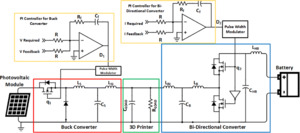
A self-replicating rapid prototyper (RepRap) is a type of 3-D printer capable of printing many of its own components in addition to a wide assortment of products from high-value scientific or medical tools to household products and toys. There is some evidence that these printers could provide low-cost distributed manufacturing in underprivileged rural areas. For the most isolated communities without access to the electric grid, a low-cost alternative energy is needed. Solar energy can be harvested through a stand-alone photovoltaic (PV) power system specifically designed to match the needs of the RepRap. The voltage and current requirement for the printer demands the use of buck along with a bidirectional DC converters to ensure proper operation. This paper provides the design for a stand-alone PV—lithium ion battery power system with an efficient controller. Robust and agile PI controller schemes are utilized to efficiently maintain the distribution of energy through the power system. The system was defined with ordinary differential equations, simulated and tested for two operational conditions in MATLAB/Simulink. The results showed that the controller developed operates the system in a stable condition and the simulation shows steady acceptable behavior that makes this system highly suitable for hardware implementation.
Keywords[edit | edit source]
Appropriate Technology; Distributed Manufacturing; Open Source Hardware; Photovoltaic; Solar Energy; 3D Printing; OSAT; off grid; Distributed power; Electrical storage
Other Versions of Solar Powered 3-D Printers[edit | edit source]
- Mobile Open-Source Solar-Powered 3-D Printers for Distributed Manufacturing in Off-Grid Communities - for the first two versions of mobile solar powered 3D printers
- Markus Kayser's solar concentrator sand sinter 3D printer
- Mark Fuller's PV-powered Mendel: https://www.youtube.com/watch?v=zzo-M5c_73Y
- The inventor of RepRap, Adrian Bowyer, in a true show of classiness is running his RepRap making factory off solar power and feeding the excess back into the grid.[1]
- Solar powered Gigabot
See also[edit | edit source]
- High-Efficiency Solar-Powered 3-D Printers for Sustainable Development
- Open-source, self-replicating 3-D printer factory for small-business manufacturing
- Distributed manufacturing with 3-D printing: a case study of recreational vehicle solar photovoltaic mounting systems
- Global value chains from a 3D printing perspective
- Development of a Resilient 3-D Printer for Humanitarian Crisis Response
- Open-source 3-D Printing in Managing Humanitarian Innovation





